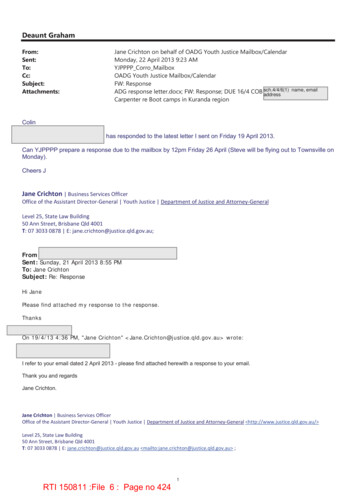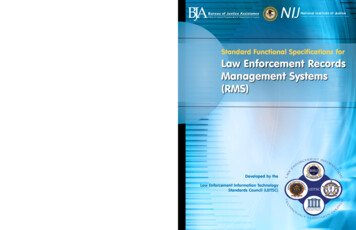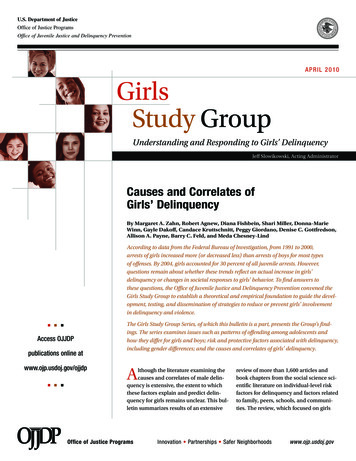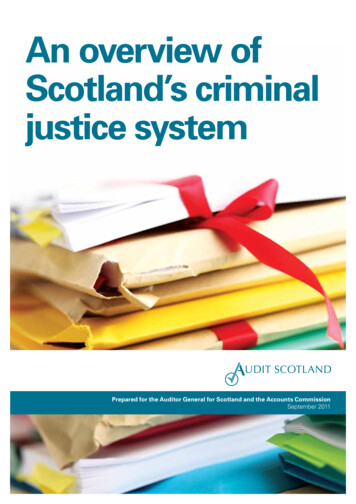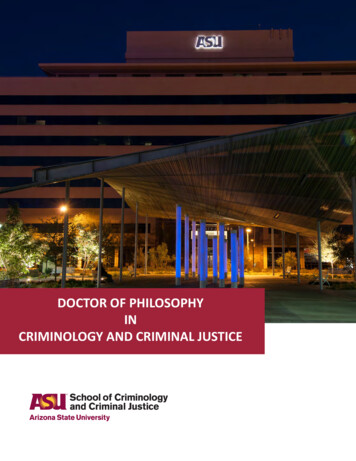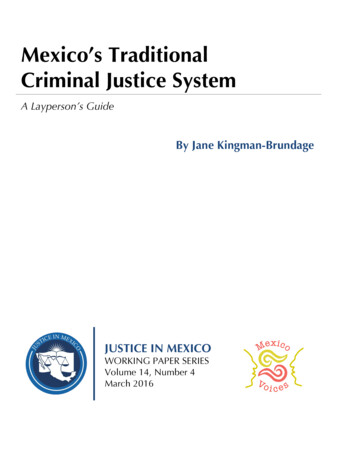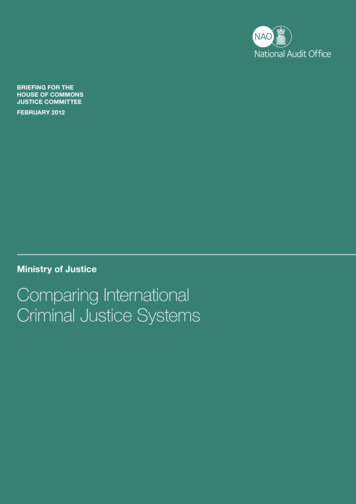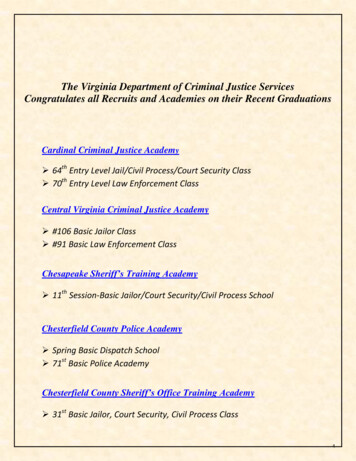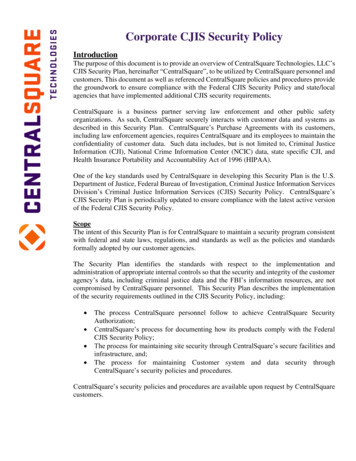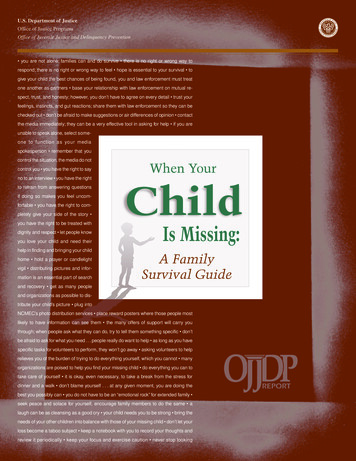
Transcription
U.S. Department of JusticeOffice of Justice ProgramsOffice of Juvenile Justice and Delinquency Prevention
U.S. Department of JusticeOffice of Justice Programs810 Seventh Street NW.Washington, DC 20531Eric H. Holder, Jr.Attorney GeneralLaurie O. RobinsonAssistant Attorney GeneralJeff SlowikowskiActing AdministratorOffice of Juvenile Justice and Delinquency PreventionOffice of Justice ProgramsInnovation Partnerships Safer Neighborhoodswww.ojp.usdoj.govOffice of Juvenile Justice and Delinquency Preventionwww.ojp.usdoj.gov/ojjdpThis document was prepared by the National Gang Center under Cooperative Agreement Number2007–JV–FX–0008 from the Office of Juvenile Justice and Delinquency Prevention (OJJDP).The Office of Juvenile Justice and Delinquency Prevention is a component of the Office ofJustice Programs, which also includes the Bureau of Justice Assistance; the Bureau of Justice Statistics; the Community Capacity Development Office; the National Institute of Justice;the Office for Victims of Crime; and the Office of Sex Offender Sentencing, Monitoring,Apprehending, Registering, and Tracking (SMART).
Second EditionOctober 2010
ForewordSince its inception, the Office of Juvenile Justice and JuvenileDelinquency Prevention (OJJDP) has initiated and supported abroad range of research, demonstration, evaluation, and trainingand technical assistance initiatives to prevent and reduce gang crime. Acentral focus of these anti-gang efforts is to support community endeavorsto provide youth with a safe environment in which to grow up.As part of that comprehensive initiative, OJJDP launched the Gang Reduction Program in 2003.The multimillion-dollar initiative was designed to reduce gang crime in targeted neighborhoodsby incorporating research-based interventions to address individual, family, and community factorsthat contribute to juvenile delinquency and gang activity. The program leveraged local, State, andFederal resources in support of community partnerships that implement progressive practices inprevention, intervention, suppression, and reentry.Best Practices To Address Community Gang Problems: OJJDP’s Comprehensive Gang Model providescommunities considering implementing the comprehensive gang model with critical informationto guide their efforts. The Report describes the research that produced the model; outlines bestpractices obtained from practitioners with years of experience in planning, implementing, andoverseeing variations of the model in their communities; and presents essential findings fromevaluations of several programs that demonstrate the success of the model in a variety ofenvironments.OJJDP commends the progress made in the demonstration sites, and we wish them continued suc cess. We remain committed to assisting other communities in assessing their gang problems anddeveloping a complement of anti-gang strategies and activities to address this complex challenge.Jeff SlowikowskiActing AdministratorOffice of Juvenile Justice and Delinquency PreventionForeword iii
AcknowledgmentsThis document is the result of the work of many people at theOffice of Juvenile Justice and Delinquency Prevention (OJJDP),the National Gang Center, and communities across the country.OJJDP wishes to thank those who have worked to support the OJJDPComprehensive Gang Model and other multistrategy anti-gang initiativesto reduce gang crime, especially violence, in targeted communities.Many people contributed directly and indirectly to this Report. Dr. Spergel and his colleaguesat the University of Chicago conducted the research and guided the early development of theComprehensive Gang Model.With funding and leadership from OJJDP, the Model has been tested in various forms in morethan 20 sites. Hundreds of community members have contributed their vision, energy, and leader ship to the planning and implementation processes in their communities. They shared with us thepractices that were most helpful to them along the way. Space does not permit listing them indi vidually, but this Report would not have been possible without the vision and hard work of thesepartners.Finally, we would like to recognize the contributions of the staff of the National Gang Center, whoprovide technical assistance and training to the communities demonstrating the Model, and whoassisted in preparing this Report.Acknowledgments v
Table of ContentsForeword . iiiAcknowledgments .vPurpose and Organization of the Report.ixDevelopment of OJJDP’s Comprehensive Gang Model. 1Research Foundation of the Comprehensive Gang Model . 1National Assessment of Gang Problems and Programs. 1Development of the Comprehensive Community-Wide Gang Program Model . 2OJJDP’s Comprehensive Gang Model . 3The Comprehensive Gang Model in Action—OJJDP’s Gang Reduction Program . 3Best Practices for Planning and Implementing the Comprehensive Gang Model . 5Convening a Steering Committee. 6Administering the Program. 7Lead Agency. 7Program Director . 10Assessing the Gang Problem . 11Planning for Implementation. 14Implementing the Program. 16Maintaining the Steering Committee . 16The Intervention Team . 19Outreach Workers. 20Law Enforcement Personnel . 23Selecting Program Activities. 25Intervention Activities . 25Prevention Activities. 25Suppression/Social Control Activities. 27Reentry Activities . 28Sustaining the Program . 29Notes. 33References . 35Appendix A: Demonstration and Testing of the Comprehensive Gang Model. 37Appendix B: Multistrategy Gang Initiative Survey . 53Table of Contents vii
Purpose and Organizationof the ReportThis Report provides guidance for communities that are consider ing how best to address a youth gang problem that already ex ists or threatens to become a reality. The guidance is based onthe implementation of the Comprehensive Gang Model (Model) devel oped through the Office of Juvenile Justice and Delinquency Prevention(OJJDP), U.S. Department of Justice (DOJ), and tested in OJJDP’s GangReduction Program.The Report describes the research that produced the Model, notes essential findings from evalua tions of several programs demonstrating the Model in a variety of environments, and outlines“best practices” obtained from practitioners with years of experience in planning, implementing,and overseeing variations of the Model in their communities.The Model and best practices contain critical elements that distinguish it from typical programapproaches to gangs. The Model’s key distinguishing feature is a strategic planning process thatempowers communities to assess their own gang problems and fashion a complement of antigang strategies and program activities. Community leaders considering this Model will be ableto call on the OJJDP Strategic Planning Tool at no cost �s Socioeconomic Mapping and Resource Topography (SMART) system is another onlineresource available through the OJJDP Web site (go to http://www.ojp.usdoj.gov/ojjdp, and select“Tools”).The main section of the Report presents best practices for the Comprehensive Gang Model andhighlights results of a survey and a meeting of practitioners regarding their experiences in imple menting the Model. This section contains specific practices that work best in a step-by-step plan ning and implementation process for communities using the Comprehensive Gang Modelframework and tools.Purpose and Organization of the Report ix
Section 1:Development of OJJDP’sComprehensive Gang ModelResearch Foundation of the Comprehensive Gang ModelThe Comprehensive Gang Model is the product of a nationalgang research and development program that OJJDP initiatedin the mid-1980s. A national assessment of gang problems andprograms provided the research foundation for the Model, and its keycomponents mirror the best features of existing and evaluated programsacross the country.National Assessment of Gang Problemsand ProgramsIn 1987, OJJDP launched a Juvenile Gang Suppression andIntervention Research and Development Program that Dr.participants identified as being affiliated with or being apartner in each local program. Spergel and his team ofresearchers interviewed program developers and re viewed all available program documentation.Irving Spergel of the University of Chicago directed. InThe more demanding project goal was to identify thethe initial phase, the researchers conducted the first com contents of each program and self-reported measures ofprehensive national assessment of organized agency andsuccess. The team made an effort to identify the “mostcommunity group responses to gang problems in thepromising” programs. In each of the most promising com United States (Spergel, 1990, 1991; Spergel and Curry,munity programs, the research team identified the agen 1993). It remains the only national assessment of effortscies that were essential to the success of the program.to combat gangs. In the second phase, Spergel and hisFinally, Spergel and his team made site visits to selectedcolleagues developed a composite youth gang programcommunity programs and agencies.based on findings from the national assessment.Spergel and Curry (1993, pp. 371–72) used agency repre In the research phase of the project (phase one), Spergel’ssentatives’ responses to five survey questions1 to deter research team attempted to identify every promisingmine the strategies that communities across the countrycommunity gang program in the United States based onemployed in dealing with gang problems. From respon a national survey. At the outset, this study focused on 101dents’ answers to these questions, the research teamcities in which the presence of gangs was suspected. Theidentified five strategies—community mobilization, socialteam found promising gang programs in a broad rangeintervention, provision of opportunities, organizationalof communities across the Nation. Once programs andchange and development, and suppression (see “Fivesites were identified, the team collected information onStrategies in OJJDP’s Comprehensive Gang Model” onthe magnitude and nature of local gang problems frompage 2).2representatives of each agency or organization that otherDevelopment of OJJDP’s Comprehensive Gang Model 1
Development of the ComprehensiveCommunity-Wide Gang Program ModelSpergel and his colleagues (Spergel, 1995; Spergel et al.,1992; Spergel and Curry, 1993) developed the Comprehen n Management of the collaborative process. In a typicalcommunity, the mobilization process evolves throughseveral stages before fruition.n Development of goals and objectives. These must in sive Community-Wide Gang Program Model as the finalclude short-term suppression and outreach services forproduct of the gang research and development programtargeted youth, and longer term services, such as re that OJJDP funded. From the information gatheredmedial education, training, and job placement.through its multimethod study in phase one (Spergel,Curry, et al., 1994), the Spergel team developed technicaln Relevant programming. The community must system assistance manuals for each of the 12 types of agencies thatatically articulate and implement rationales for ser should be part of a successful local community response tovices, tactics, or procedures.gangs, including organizations that range from grassrootschild-serving agencies to law enforcement, courts, andprosecutors’ offices (Spergel, Chance, et al., 1994).Spergel and his colleagues also offered the general com munity design of an ideal Comprehensive CommunityWide Gang Program Model. An ideal program shouldn Coordination and community participation. A mobi lized community is the most promising way to dealwith the gang problem.n Youth accountability. While youth gang members mustbe held accountable for their criminal acts, they mustundertake several action steps (Spergel, Chance, et al.,at the same time be provided an opportunity to1994, pp. 2–5):change or control their behavior.n Addressing the problem. A community must recognizen Staffing. Youth gang intervention and control effortsthe presence of a gang problem before it can do any require a thorough understanding of the complexitything meaningful to address the problem.of gang activity in the context of local community life.n Organization and policy development. Communitiesmust organize effectively to combat the youth gangn Staff training. Training should include prevention, in tervention, and suppression in gang problem localities.problem.n n n FiveStrategies in OJJDP’s Comprehensive Gang ModelCommunity Mobilization: Involvement of local citizens,including former gang-involved youth, community groups,agencies, and coordination of programs and staff func tions within and across agencies.Opportunities Provision: Development of a variety ofspecific education, training, and employment programstargeting gang-involved youth.Social Intervention: Involving youth-serving agencies,schools, grassroots groups, faith-based organizations, po lice, and other juvenile/criminal justice organizations in“reaching out” to gang-involved youth and their families,and linking them with the conventional world and neededservices.Suppression: Formal and informal social control proce dures, including close supervision and monitoring of ganginvolved youth by agencies of the juvenile/criminal justicesystem and also by community-based agencies, schools,and grassroots groups.Organizational Change and Development: Developmentand implementation of policies and procedures that resultin the most effective use of available and potential re sources, within and across agencies, to better address thegang problem.Source: Spergel, 1995, pp. 171–296.2 Best Practices To Address Community Gang Problems: OJJDP’s Comprehensive Gang Model
n Research and evaluation. Determining what is mosteffective, and why, is a daunting challenge.n Establishment of funding priorities. Based on availableCommunities that use the Comprehensive Gang Modelwill benefit from the simplified implementation processthat OJJDP has created. OJJDP synthesized the elementsof the Comprehensive Gang Model into five steps:research, theory, and experience, community mobiliza tion strategies and programs should be accorded thehighest funding priority.In 1993, Spergel began to implement this model in a neigh 1. The community and its leaders acknowledge the youthgang problem.2. The community conducts an assessment of the natureborhood in Chicago. Soon thereafter, OJJDP renamed theand scope of the youth gang problem, leading to themodel the Comprehensive Gang Prevention and Interven identification of a target community or communitiestion Model (Spergel, Chance, et al., 1994, p. iii).and population(s).3. Through a steering committee, the community and itsOJJDP’s Comprehensive Gang ModelThe 1992 amendments to the Juvenile Justice and Delin quency Prevention Act authorized OJJDP to carry out ad leaders set goals and objectives to address the identi fied problem(s).4. The steering committee makes available relevantditional activities to address youth gang problems. Anprograms, strategies, services, tactics, and proceduresOJJDP Gang Task Force outlined plans for integrated of consistent with the Model’s five core strategies.ficewide efforts to provide national leadership in the ar eas of gang-related program development, research,5. The steering committee evaluates the effectivenessstatistics, evaluation, training, technical assistance, andof the response to the gang problem, reassesses theinformation dissemination (Howell, 1994; Tatem-Kelley,problem, and modifies approaches, as needed.1994).This background work led to the establishment of OJJDP’sThese steps have been tested in several settings. Informa tion on those initiatives is provided in appendix A.Comprehensive Response to America’s Youth Gang Prob lem. The Comprehensive Response was a five-componentinitiative that included establishment of the NationalGang Center, demonstration and testing of OJJDP’s Com prehensive Gang Model, training and technical assistanceThe Comprehensive Gang Modelin Action—OJJDP’s Gang ReductionProgramto communities implementing this Model, evaluation ofOver the years, OJJDP has tested and refined the Compre the demonstration sites implementing the Model, andhensive Gang Model to meet new challenges and addressinformation dissemination through the Juvenile Justicegang problems in new locations. Using the Comprehen Clearinghouse. Implementation and testing of the Com sive Gang Model, OJJDP developed and funded the Gangprehensive Gang Model were the centerpiece of the ini Reduction Program (GRP).tiative. OJJDP prepared two publications specifically tosupport demonstration and testing of the Model: GangGangs are often the result of system failures or commu Suppression and Intervention: Problem and Responsenity dysfunction. So, to address youth gang violence, the(Spergel, Curry, et al., 1994), and Gang Suppression andOJJDP Administrator decided to test whether the ModelIntervention: Community Models (Spergel, Chance, et al.,could be used to initiate community change in certain1994).cities. In 2003, OJJDP identified four demonstration sites:Los Angeles, CA; Richmond, VA; Milwaukee, WI; andDevelopment of OJJDP’s Comprehensive Gang Model 3
North Miami Beach, FL. Each test site faced a differentgang problem.Once sites had been identified, OJJDP held meetings withsenior political and law enforcement officials and madean offer: OJJDP would provide resources to support a testof the Comprehensive Gang Model if the city agreed tochange how they currently addressed youth gang prob lems. Each city would now focus on balancing gangprevention with enforcement and commit to using com munity organizations and faith-based groups to ultimate ly sustain the work. Additionally, each site would have afull-time coordinator, funded by OJJDP, with direct accessto senior political and police leadership. This coordinatorn Secondary prevention identifies young children (ages7–14) at high risk and—drawing on the resources ofschools, community-based organizations, and faithbased groups—intervenes with appropriate servicesbefore early problem behaviors turn into serious delin quency and gang involvement.n Intervention targets active gang members and closeassociates, and involves aggressive outreach and re cruitment activity. Support services for gang-involvedyouth and their families help youth make positivechoices.n Suppression focuses on identifying the most danger would be free from substantive program responsibilitiesous and influential gang members and removing themand would ensure that each participating agency or orga from the community.nization met its obligations. He or she would also ensurethat the data and information generated by the effortn Reentry targets serious offenders who are returning towould be collected and shared. Each participating agencythe community after confinement and provides appro remained independent, but was under the oversight ofpriate services and monitoring. Of particular interestthe gang coordinator, who had the ability to obtain sup are displaced gang members who may cause conflictport or intervention from OJJDP leadership and localby attempting to reassert their former gang roles.authorities (e.g., mayor, police chief, or governor).In addition to reducing gang violence, the goal of GRPwas to determine the necessary practices to create a com munity environment that helps reduce youth gang crimeand violence in targeted neighborhoods. Because of this,GRP focused on two goals: to learn the key ingredientsThe program has several key concepts:n Identify needs at the individual, family, and commu nity levels, and address those needs in a coordinatedand comprehensive response.n Conduct an inventory of human and financial resourc for success and to reduce youth gang delinquency, crime,es in the community, and create plans to fill gaps andand violence. GRP accomplishes these goals by helpingleverage existing resources to support effective gang-communities take an integrated approach when target reduction strategies.ing gangs:n Apply the best research-based programs across appro n Primary prevention targets the entire population inhigh-crime and high-risk communities. The key compo priate age ranges, risk categories, and agencyboundaries.nent is a One-Stop Resource Center that makes servicesaccessible and visible to members of the community.n Encourage coordination and integration in two direc Services include prenatal and infant care, afterschooltions: vertically (local, State, and Federal agencies) andactivities, truancy and dropout prevention, and jobhorizontally (across communities and program types).programs.Highlights of activities from each of the Gang ReductionProgram sites—Richmond, VA; Los Angeles, CA; NorthMiami Beach, FL; and Milwaukee, WI—are presented inthe next section.4 Best Practices To Address Community Gang Problems: OJJDP’s Comprehensive Gang Model
Section 2:Best Practices for Planning andImplementing the Comprehensive Gang ModelThe best practices presented in this report are based on years ofdemonstration and evaluation in many sites across the country.Appendix A provides an overview of these demonstration ini tiatives, beginning with the initial implementation of the Model in theLittle Village neighborhood in Chicago in the early 1990s, through OJJDPsponsored demonstrations of the Model in five sites in the mid-1990s, toOJJDP’s current efforts to implement its Gang Reduction Program (GRP).To determine which practices would be most beneficial toOJJDP sponsored in November 2007. Representativescommunities intent on implementing the OJJDP Compre from OJJDP, NGC, the initial demonstration sites,hensive Gang Model, the National Gang Center (NGC)Gang-Free Schools and Communities programs, Gangcollected data from these sources:Reduction Program projects, and programs in Okla n Comprehensive Gang Model Survey. A ComprehensiveGang Model Survey (see appendix B) was conducted inJuly 2007. It collected information pertaining to sev eral sites in the original demonstration program (Sper gel Model), the Rural Gang Initiative, the Gang-Freehoma, Utah, Nevada, and North Carolina met todiscuss and record best practices based on their experi ence with comprehensive anti-gang programming. Themeeting also produced a timeline for use by communi ties that are considering implementing such efforts.Schools and Communities Initiative, and the Gang Re n Evaluation Reports and Staff Observations. “Best prac duction Program, and from selected projects and pro tices” of demonstration programs (described in appen grams in Oklahoma, Utah, Nevada, and North Carolinadix A) and observations of OJJDP and NGC staff whothat used the OJJDP Model but OJJDP did not fund.have worked with these programs for 15 years wereThe survey included questions about the assessmentnoted in the evaluations.and implementation processes, program coordination,the lead agency, administrative structure, prevention,intervention and the intervention team, suppression,reentry, organizational change and development, andsustainability.The best practices identified from these sources are orga nized into seven categories—convening a steering com mittee, administering the program, assessing the gangproblem, planning for implementation, implementingthe program, selecting program activities, and sustainingn Practitioner Meeting. The preliminary survey resultsthe program—and are described below.were used to develop an agenda for a meeting thatBest Practices for Planning and Implementing the Comprehensive Gang Model 5
Convening a Steering CommitteeTo be effective, the steering committee should:How a community begins to address gang problems dif n Include, at a minimum, representation from thefers depending on the event or events that draw publicfollowing groups: law enforcement, corrections,attention to the issue. In some cases, a high-profile, oftenprobation/parole (juvenile and adult), schools, socialtragic event occurs that galvanizes the community andservices agencies, local units of government, faith-stimulates mobilization to address gangs. In other cases, abased organizations, religious institutions, employ groundswell of public support to deal with gangs buildsment programs, and community residents.more gradually and lacks only an individual or agency ton Make and oversee policy for the project.serve as a catalyst. At some point, key agencies and com munity leaders begin to openly discuss and address gangn Oversee and provide general direction to the agenciesissues. At that point, a standing task force, committee, orcollaborating in conducting an assessment of the gangorganizational structure (henceforth referred to as theproblem and planning/implementing the project.steering committee) should be convened and begin towork on next steps. Ideally, this group oversees an assess The membership of the steering committee is an essentialment of the local gang problem and, using data obtainedelement in determining program success. Steering com through the assessment, develops strategies to combat it.mittees with well-respected leaders (chairs or cochairs)who have a reputation for problem-solving and objectiv In virtually every demonstration of OJJDP’s Comprehen ity have proven most successful.sive Gang Model, the effectiveness of its steering commit tee has been crucial in determining the success or failureBest results have been obtained when the steering com of the community in implementing a comprehensivemittee mixes two groups:approach.n Individuals from upper-level management in key part nering agencies who can effect organizational changewithin their own agencies.n n n OJJDPComprehensiveComprehensive Gang ModelCore Strategy: Community MobilizationCritical Elementsu Local citizens, including youth, community groups, andagencies, are involved, and programs and functions ofstaff within and across agencies are coordinated.u A steering committee is available to initiate the projectby involving representatives of key organizations andthe community and to guide it over time by respondingto barriers to implementation, developing sound policy,lending support to the project where and when appro priate, and taking general ownership of the commu nitywide response.u The steering committee also is charged with creatingand maintaining interagency and community relation ships that facilitate program development. For example,the committee could create coordinated outreach andlaw enforcement policies and practices and facilitatethe development of community groups such as blockwatches, neighbors/mothers against gangs, or othercommunity alliances and coalitions.u The program is supported and sustained across all levels(top, intermediate, and street/line) of the criminal andjuvenile justice systems, schools, community-based andgrassroots organizations, and government.6 Best Practices To Address Community Gang Problems: OJJDP’s Comprehensive Gang Model
n Individuals with influence w
October 2010. Foreword. S ince its inception, the Ofice of Juvenile Justice and Juvenile Delinquency Prevention (OJJDP) has initiated and supported a broad range of research, demonstration, evaluation, and training and technical assistance initiatives to prevent and reduce gang crime. A
